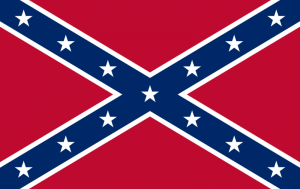 When the average American who was born and raised in the United States sees what they perceive as the Confederate Flag, certain thoughts and emotions well up or at least pass through their minds. Typically, it is either a thought of as a symbol of southern pride or white racism or just no positive or negative reaction at all. In 2011, a pew research poll[i] showed about 10% had a positive reaction, 30% had a negative reaction to the Confederate Flag. Approximately 58% had neither positive nor negative reaction. The reason for this is that the civil war in the later part of the 19th century still holds very deep emotions in the American psyche, but as time passes, more diverse cultures and less historical knowledge evade the masses. The truth is that there were at least three confederate flags used and designed with several other sub flag categories. We will simply use the most common one that most think of which is the Second National flag, used from May 1863 to March 1865. It is the “Confederate Flag” we will discuss.
When the average American who was born and raised in the United States sees what they perceive as the Confederate Flag, certain thoughts and emotions well up or at least pass through their minds. Typically, it is either a thought of as a symbol of southern pride or white racism or just no positive or negative reaction at all. In 2011, a pew research poll[i] showed about 10% had a positive reaction, 30% had a negative reaction to the Confederate Flag. Approximately 58% had neither positive nor negative reaction. The reason for this is that the civil war in the later part of the 19th century still holds very deep emotions in the American psyche, but as time passes, more diverse cultures and less historical knowledge evade the masses. The truth is that there were at least three confederate flags used and designed with several other sub flag categories. We will simply use the most common one that most think of which is the Second National flag, used from May 1863 to March 1865. It is the “Confederate Flag” we will discuss.
It represents a civil war (April 12, 1861- May 9, 1865) that nearly destroyed the United States as we know it today. It was mostly about the right of states to self-govern as delineated in the first 10 amendments of the constitution, and less about slavery. However, again, it is the emotions of slavery, white supremacy and racism that come to mind with this flag. For this reason we will consider the political complications of this flag with respect to racism and white supremacy and racism.
What America Accomplished
It can be stated that slavery has been part of this world for several millennia and is today a very common occurrence in many parts of the world. However, at the founding of our nation, we were no different as slavery was part of the way of life for the southern states. Our founding fathers placed within the constitution the ability for the people to redress their government. So the political will to abolish slavery was not in place in the late 1700’s, but the mechanism to address this was by way of a constitution that has passed the test of time.
So within the first 100 years of the United States of America, from 1776 through 1865, America abolished a practice that has been a staple of the rest of the world. Then for the next 100 years up until the civil rights movements of the 1960’s, America was trying to figure out how to coexist as a melting pot of different races, mainly whites and blacks. From the 1960’s to the present, the amounts of reforms that have been addressed to provide equal access and equality have been substantial. One could argue the either Abraham Lincoln or Martin Luther King, Jr would not recognize this country as the slavery country it once was. They would have potentially considered their missions a success.
The Flag Significance
Initially the flag was displayed at events that commemorated veterans and Confederate Soldiers who lost their lives in the War Between the States! It was in the 1940’s that the flag was used in contexts outside of the civil war and in the area of sports and football. In 1948, the Dixiecrat Party used this flag as its resistance to the federal government. Years later, the flag was part of the symbol for segregation and in 1956 it was placed predominately as part of Georgia’s state flag. It was during this time that the flag came into more symbolic prominence because of school desegregation and even used by the Klu Klux clan.
America’s Republican and Democratic Parties give mixed signals
It should be noted that the Grand Ole Party (GOP) was the party that won the civil war under the Presidency of Abraham Lincoln and is also known as the Republican Party today and referred to as the GOP. It was this party that issued the emancipation proclamation freeing the slaves.
During the civil rights movement of the 1960’s it was the higher percentage of Republicans that voted for the bill than the Democrats. However, when one takes a closer look, it will be noted that it was the Union States of both Parties that were in the majority (90%) in passing the Civil Rights act of 1964. The Confederacy States represented less than 10% in a passing vote. The confederate flag represents in symbol the confederate southern states of the civil war.
The National Association for the Advancement of Colored People ( NAACP) has always boycotted the use of the battle flag in South Carolina at the capitol. Even as recently as 2015 Mitt Romney, former Republican presidential contender, has called for the removal of the Confederate Flag in the South Carolina State House. California has banned it.
This short expose is a very brief introduction to the political complications involved in the history of the Confederate Flag. It runs deep in the southern states and has significance for all the states and all Americans now.
[i] Pew Research Center, March 30 – April 3, 2011. Figures may not add to 100% due to rounding











Leave a Reply